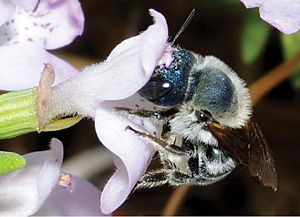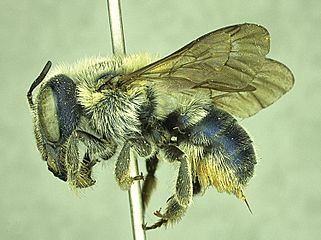Blue calamintha bee facts for kids
Quick facts for kids Blue calamintha bee |
|
|---|---|
 |
|
| O. calaminthae visiting Calamintha flowers | |
| Conservation status | |
| Scientific classification | |
| Genus: |
Osmia
|
| Species: |
calaminthae
|
The Osmia calaminthae, also known as the blue calamintha bee, is a very rare type of mason bee. It has only been found in Highlands County, Florida, in the United States. This bee is considered Critically Imperiled by NatureServe, which means it is at a very high risk of disappearing forever. Its common name comes from its beautiful blue color and its favorite plant, the Calamintha ashei.
Contents
What's in a Name?
The name "calaminthae" comes from a Latin word for mint. This is because the bee mostly collects pollen from a plant called Calamintha ashei, which is also known as Ashe's mint.
What Does It Look Like?
Adult female blue calamintha bees are about 10 to 11 millimeters long. That's about the length of a small fingernail! Their front wings are about 6 to 7 millimeters long. The males are a bit smaller, around 10 millimeters long, with front wings about 6 millimeters long.
The female bees are a dark blue color with some brown parts on their bodies. Male bees have a light blue head and middle body section, with a dark blue back part. They also have some brown areas. Female blue calamintha bees have special short, straight hairs on their faces. These hairs help them collect pollen, and they are unique among many other mason bees in North America.
Where Do They Live and What Do They Eat?
The blue calamintha bee has only been seen in four places. All these spots are within a small area in Highlands County, Florida. This area is about 20 kilometers long and 2 kilometers wide. It is a sandy Florida scrub habitat, which is a unique type of shrub environment. Most sightings have been in undeveloped areas near Lake Placid.
This bee might be one of the most geographically limited bees in eastern North America. This means it lives in a very small area. It also depends mostly on one type of plant for food. While it's possible the bee lives in other places, no one has fully explored Florida to find all its bees and their food sources. The area where this bee lives is also known for having many unique plants and animals found nowhere else.
The blue calamintha bee mainly gets its pollen from the Calamintha ashei plant. These plants can live for at least ten years, and possibly longer. They usually bloom, or flower, from mid-March to mid-April. Even a small number of these plants can produce thousands of flowers. This makes them a very reliable food source for the blue calamintha bee every year.
Protecting the Blue Calamintha Bee
Not much is known about the blue calamintha bee, and its protection status is still being reviewed by the United States Fish and Wildlife Service. However, the Florida State Wildlife Action Plan lists it as a "species of greatest conservation need." This means it needs special attention to help it survive. Since 2019, NatureServe has listed it as Critically Imperiled.
The bee was first described in 2011, and its home was studied in 2016. For a while, people weren't sure if it still existed. But thankfully, it was found again in March 2020!
Most of the places where this bee lives are not protected. This means they could be developed into buildings or roads. Other dangers to the bee include pesticides that blow onto their habitat and damage from all-terrain vehicles driving through their homes. Efforts are being made to understand and protect this special blue bee.
See also
 In Spanish: Abeja azul calamintha para niños
In Spanish: Abeja azul calamintha para niños




